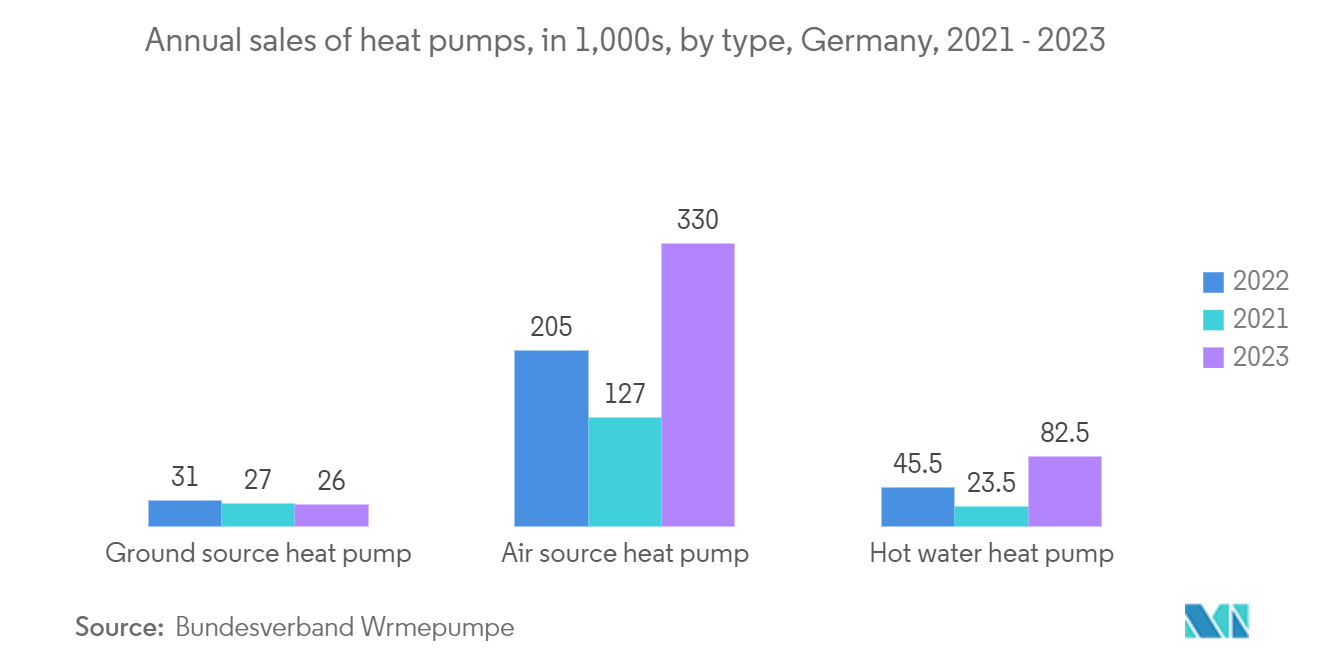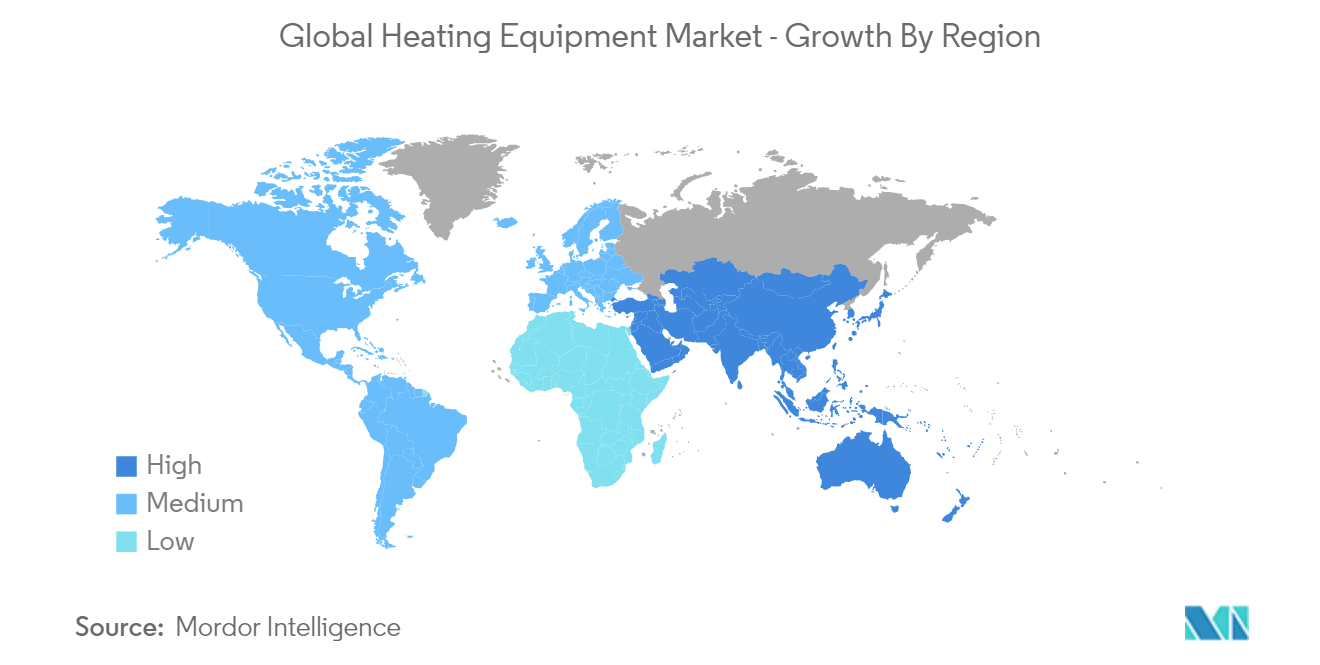Market Trends of Heating Equipment Industry
Heat Pump is Expected to Hold a Major Market Share
- Energy is a critical power source in homes, hospitals, and schools. However, its manufacturing and use result in significant greenhouse gas emissions. As a result, major economies worldwide are attempting to minimize their reliance on nonrenewable energy sources while progressively shifting toward renewable energy sources to limit greenhouse gas emissions. Heat pump technology is a viable way to reduce greenhouse gas emissions. Aerothermal and geothermal heat pumps offer an energy-efficient solution to space heating.
- The deployment of heat pumps has increased steadily in the North American region, especially in the United States, due to varied reasons, like the convenience of offering the equipment, climatic conditions, government tax credit benefits, and regulations. Furthermore, the heat pumps have been regulated by the governments in the region for their energy efficiency. For instance, the Department of Energy announced Fan Energy Rating, which sets a minimum airflow efficiency standard for residential furnace fans.
- With the new FER standards, the US DOE estimates that the new standard for furnace fans might save approximately 3.99 quads of energy, minimize carbon pollution by 34 million metric tons, and provides American citizens with savings of more than USD 9 billion in electric bills by 2030. According to new state law,over the next five years, the city of Maine seeks installers to help fulfill the goal of 100,000 heat pumps. Furthermore, the New Ambler heat pump project aims to drastically reduce diesel costs in the villages.
- Heat pump sales in Germany rose by more than 50% for the second year in a row in 2023, according to new figures from Bundesverband Wärmepumpe (BWP). Starting in 2024, some 500,000 new heat pumps are to be installed in Germany every year.
- Furthermore, Eastern Europe has colder climatic conditions in the region, and the demand for heating solutions is significant in these countries such as the Czech Republic, Poland, Bulgaria, and others. Similar to other countries in the region, measures to increase energy efficiency in the heating and cooling sector are on the rise. According to Stratego, which is co-founded by the Intelligent Energy Europe Programme of the EU, an investment of EUR 50 billion during the span of 2010-2050 will save enough fuel to minimize the costs of the energy system. Moreover, as part of this investment, district heating’s share amounted to EUR 5 billion, and individual heat pumps at EUR 15 billion.
- In July 2022, the National Environment Agency (NEA) Singapore reported they are exploring using heat pump water heaters in high-rise residences – condominiums and HDB units. Heat pump water heaters use only 210 watts of power, compared to the approximately 3000 watts used by typical electric or gas water heaters. A user's monthly power expenditures would be significantly reduced by the energy savings from employing a heat pump.

The Asia Pacific Region is Expected to Witness a High Market Growth
- China's vast geographic area is officially divided into five primary climate zones with different thermal design requirements. Northern China, which comprises the two coldest climate zones, requires space heating in winter. The urban areas depend on district heating systems, whereas rural regions mainly utilize individual household heating systems. Another climate zone with rising demand for heating is the hot summer and cold winter climate zone. Due to historical reasons, there is no public infrastructure or services to provide district heating systems for buildings in this climate zone, and buildings generally lack effective heating services. Therefore, China's northern and southern regions face different heating challenges and need tailored solutions.
- The Asia Pacific will have the highest revenue share. This is primarily due to the rising construction sector in nations such as China and India, which are witnessing substantial infrastructure investments, particularly in retail spaces, commercial office buildings, manufacturing facilities, and metro train lines. Additionally, increased demand for boilers in the thermal power industry is driving market expansion.
- Many of China's households still depend on small coal stoves for heat, which causes air pollution that damages health. To address these problems, the Chinese government launched a five-year "Clean Heating Plan" in 2017 to transition 70 percent of northern households away from coal and toward cleaner heating options. In 2022, as the plan reaches its final year, a novel study by Princeton University researchers offered policy guidance: Increase the usage of heat pumps in rural households. Among the options studied, the researchers found air-to-air heat pumps provide the most air quality, health, and climate benefits.
- China aims for carbon neutrality by 2060 and has engaged in a successful effort to reduce air pollution. According to Denise Mauzerall, professor of civil & environmental engineering & international affairs, replacing coal stoves in urban and rural residences with clean heaters dramatically improves air quality throughout northern China in winter while decreasing premature deaths. Also, given that China plans to be carbon neutral by 2060, "decarbonizing" their power grid or the system that delivers electricity is critical. One way to achieve this is by moving away from coal and toward more non-fossil energy.
- The regional players are developing new products to cater to a diverse range of customers' requirements. For instance, in March 2022, Panasonic introduced a new device in Japan. The Eco Cute solution comprises a heat pump and a hot water storage tank to save energy by maintaining consistent bathwater temperatures. It also saves electricity at night by utilizing the heat from a household's bathwater. Furthermore, the device conserves energy and water. The product includes a solar charging capability that uses extra power generated and stored by PV sources. It can boil water at any time of day or night using electricity.


